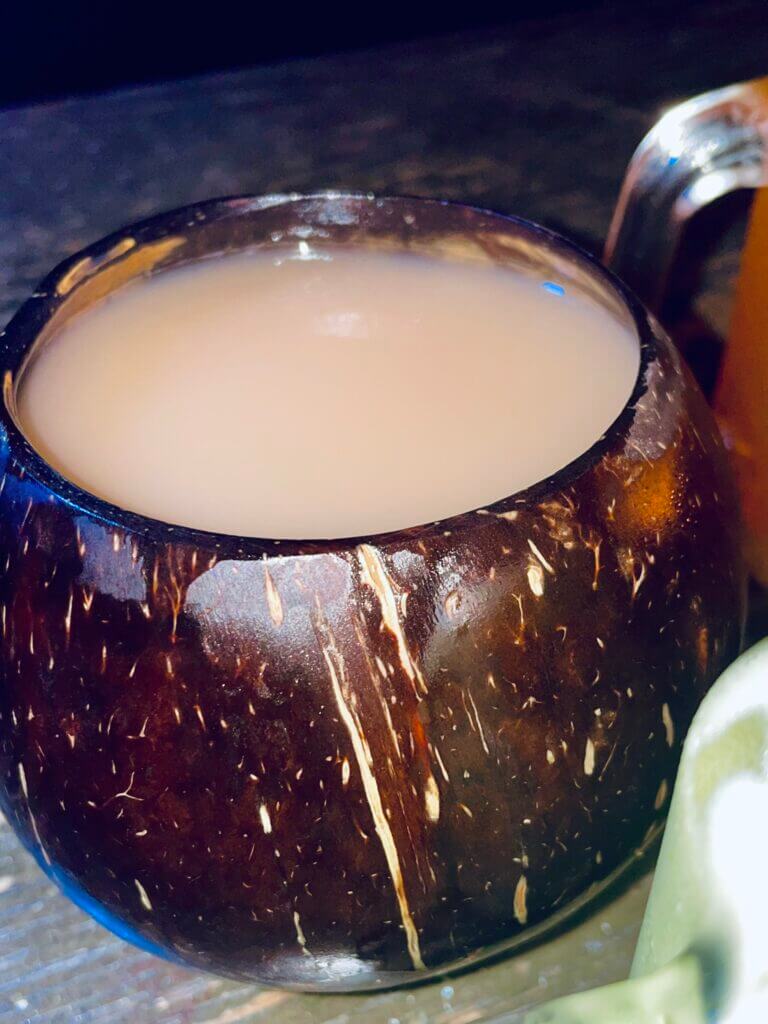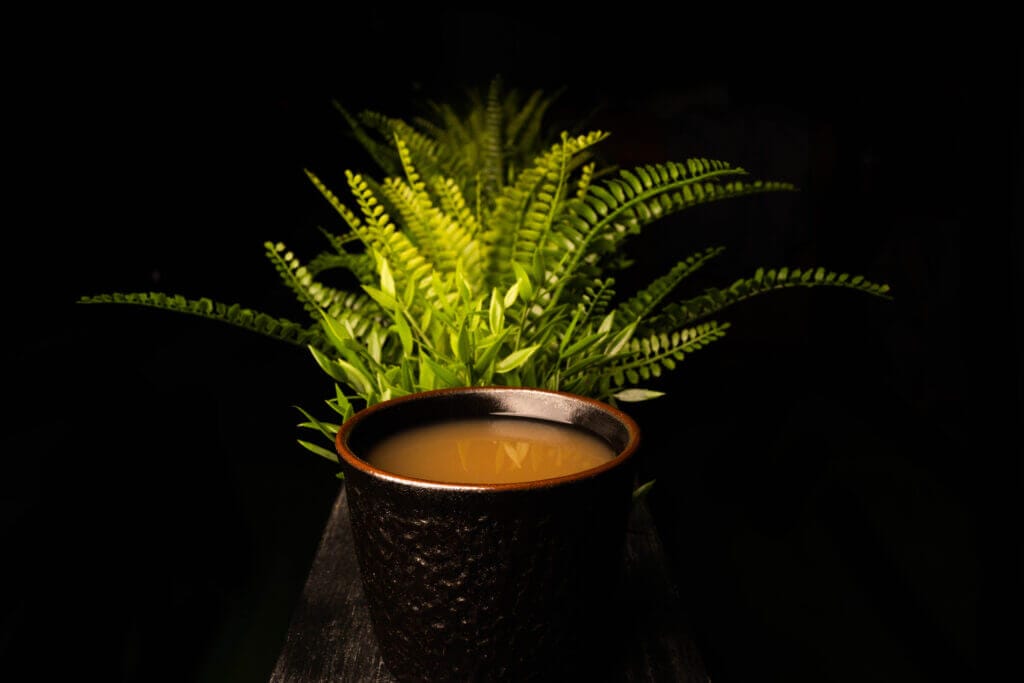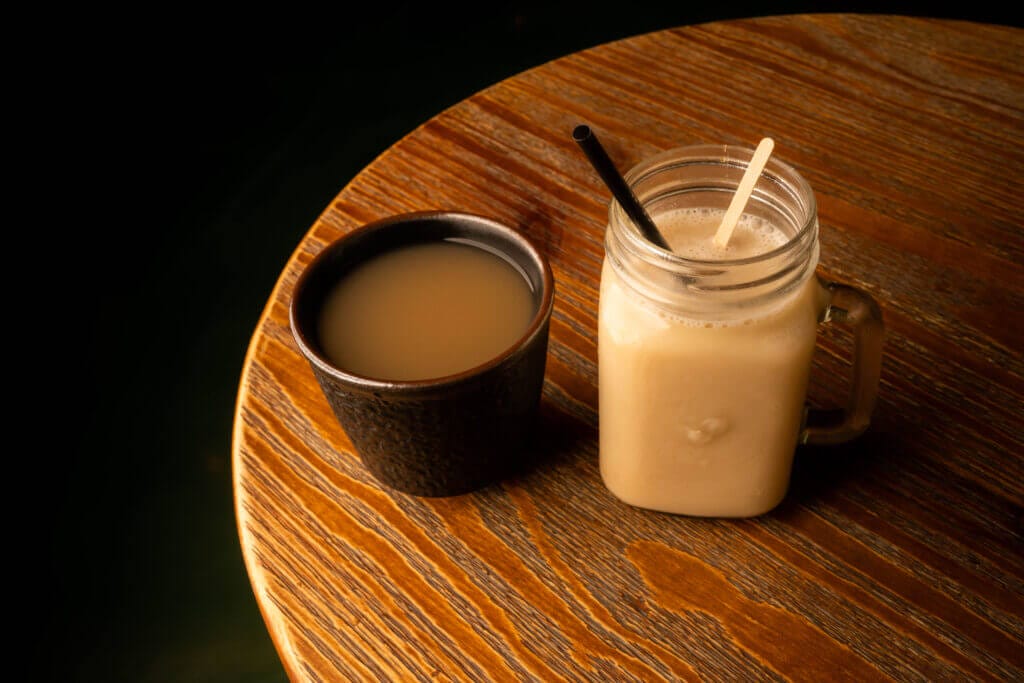How to Brew Kava? Brewing Kava traditionally involves a few key steps and considerations to ensure a proper and authentic experience. Here’s a step-by-step guide:

- How to Brew Kava? Selecting High-Quality Kava Roots:
- Begin by sourcing high-quality Kava roots from a reputable supplier. Look for roots that are fresh, mature, and free from mold or contaminants.
- How to Brew Kava? Preparation of Kava Roots:
- Start by washing the Kava roots thoroughly under running water to remove any dirt or debris.
- Once cleaned, peel the outer bark of the roots using a knife or vegetable peeler to expose the inner flesh. Discard the bark as it contains minimal active compounds.
- Cut the peeled roots into small pieces or chips to facilitate the extraction process. Aim for pieces approximately 1-2 inches in length.
- How to Brew Kava? Grinding or Crushing the Kava Roots:
- Traditionally, Kava roots are ground or pounded to a fine powder using a stone grinder, wooden pestle and mortar, or a modern grinder.
- If using a stone grinder or pestle and mortar, crush the Kava root pieces until they form a smooth, uniform powder. Alternatively, use a modern grinder to achieve the same result efficiently.
- How to Brew Kava? Straining the Kava Powder:
- Place the powdered Kava root into a muslin cloth or a porous strainer bag designed for Kava preparation.
- Immerse the bag containing the Kava powder in a bowl or large container filled with cold or lukewarm water. Use approximately 1 part Kava powder to 4-6 parts water, depending on your desired strength.
- Knead and massage the Kava-filled bag in the water for several minutes to release the active compounds into the liquid. This process is known as “kneading” or “squishing.”
- Continue kneading until the water turns a milky, opaque color, indicating the extraction of kavalactones from the Kava powder.
- How to Brew Kava? Extracting the Kava Liquid:
- Once the water has become sufficiently cloudy, carefully remove the Kava-filled bag from the bowl, allowing the liquid to drain back into the container.
- Squeeze the bag firmly to extract as much Kava liquid as possible. This ensures maximum potency and flavor in the final brew.
- How to Brew Kava? Serving and Enjoying Kava:
- Transfer the strained Kava liquid into a clean serving bowl or ceremonial cup. Traditional Kava cups, often made from coconut shells or wooden vessels, are commonly used.
- Invite participants to gather around the Kava bowl in a circle, fostering a sense of community and shared experience.
- Serve the Kava drink in small, measured doses, starting with a modest amount to gauge its effects. Allow each participant to sip slowly and savor the unique flavor and sensation of Kava.
- Throughout the drinking session, engage in conversation, storytelling, or other social activities to enhance the communal atmosphere and connection.
- How to Brew Kava? Cleanup and Storage:
- After the Kava ceremony or gathering, clean and rinse all utensils, bowls, and straining equipment thoroughly to remove any residue.
- Store any leftover Kava liquid in a sealed container in the refrigerator to preserve its freshness and potency. Consume the remaining Kava within a few days for the best flavor and effects.
How to Brew Kava? By following these traditional brewing methods, you can prepare and enjoy an authentic Kava experience that honors its cultural heritage and promotes a sense of unity and relaxation among participants.

Understanding Kava: The Sacred Elixir of the Pacific Islands
In the heart of the Pacific Islands lies a culturally significant drink that has been cherished for centuries: Kava. This mysterious brew, derived from the roots of the Piper methysticum plant, has been an integral part of social, ceremonial, and medicinal practices across the islands of the South Pacific. As its popularity spreads globally, it’s crucial to delve deeper into what Kava truly is, its cultural significance, its effects, and its place in modern society.
Kava Kava. Origins and Cultural Significance:
Kava’s history traces back thousands of years to the islands of Vanuatu, Fiji, Tonga, and Samoa, where it holds deep spiritual and social significance. The plant itself belongs to the pepper family and is cultivated primarily for its roots, which are processed to produce the iconic Kava drink. Known by various names across different island cultures, such as ‘awa in Hawaii and ‘ava in Samoa, Kava plays a central role in ceremonies, rituals, and social gatherings.
In many Pacific Island societies, the preparation and consumption of Kava are steeped in tradition. The Kava ceremony, often referred to as “the drinking of the sacred root,” involves rituals led by a designated person, such as a village chief or elder. Participants sit in a circle, sharing stories, songs, and prayers as they pass around a communal cup filled with the earthy, sedative liquid. This ritual fosters a sense of community, camaraderie, and connection with ancestors and the natural world.
Kava Kava. Chemical Composition and Effects:
The active compounds in Kava responsible for its psychoactive effects are called kavalactones. These compounds, found in the root of the Piper methysticum plant, interact with the central nervous system to produce relaxation, euphoria, and a sense of tranquility. Unlike alcohol, Kava does not impair cognitive function or cause significant intoxication. Instead, it induces a state of calmness and mental clarity, making it a popular alternative to traditional alcoholic beverages in social settings.
Kava’s effects vary depending on factors such as dosage, preparation method, and individual tolerance. Traditionally, Kava is consumed in moderation to achieve a mild, pleasant relaxation without sedation. However, excessive consumption or high concentrations of kavalactones can lead to adverse effects such as nausea, dizziness, and temporary skin discoloration, known as the “Kava dermopathy.”
Kava Kava. Medical and Therapeutic Applications:
Beyond its cultural and recreational use, Kava has gained attention for its potential therapeutic benefits. In traditional medicine, Kava has been employed to alleviate various ailments, including anxiety, stress, insomnia, and muscle tension. Research suggests that Kava may exert anxiolytic and sedative effects without causing the dependency or cognitive impairment associated with conventional pharmaceuticals.
Studies have explored Kava’s efficacy in treating anxiety disorders, with some evidence supporting its use as a natural alternative to prescription medications. Additionally, Kava extracts and supplements have gained popularity in the wellness industry, marketed for their relaxation-promoting properties and stress-relief benefits. However, it’s essential to exercise caution when using Kava products, as their safety and efficacy can vary, and interactions with other medications are possible.

Cultural Challenges and Controversies: How to Brew Kava?
Despite its rich cultural heritage and potential therapeutic value, Kava has faced challenges and controversies in recent years. In the early 2000s, concerns arose regarding the safety of Kava consumption following reports of hepatotoxicity, or liver damage, associated with certain Kava supplements. As a result, several countries, including Germany, Canada, and Australia, imposed restrictions or bans on Kava imports and sales.
These regulatory actions sparked debates within the scientific community and among proponents of traditional medicine, who argued that the reported cases of liver toxicity were rare and potentially linked to factors such as poor quality control, inappropriate use, or underlying health conditions. Subsequent research has attempted to clarify the safety profile of Kava and identify potential risk factors, leading to revised guidelines and regulations in some jurisdictions.
Kava Kava – Preserving Cultural Heritage and Sustainable Practices:
As global interest in Kava continues to grow, efforts are underway to preserve its cultural heritage and promote sustainable cultivation practices. Indigenous communities in the Pacific Islands are advocating for the protection of traditional knowledge, intellectual property rights, and fair trade practices related to Kava production and distribution.
Furthermore, initiatives aimed at sustainable farming methods, biodiversity conservation, and environmental stewardship seek to safeguard the natural resources upon which Kava cultivation depends. By fostering collaboration between local stakeholders, policymakers, and international organizations, these efforts aim to ensure that future generations can continue to enjoy the benefits of Kava while respecting its cultural and ecological significance.
Conclusion: How to Brew Kava?
Kava represents more than just a beverage; it embodies a rich tapestry of culture, tradition, and spirituality woven across the islands of the South Pacific. As interest in Kava expands beyond its traditional boundaries, it’s essential to approach its consumption, research, and regulation with sensitivity, respect, and a commitment to preserving its cultural heritage and ecological integrity.
Whether enjoyed as a ceremonial elixir, a social lubricant, or a natural remedy, Kava invites us to pause, connect, and reflect on the timeless wisdom of indigenous cultures and the healing power of the natural world. As we raise our cups in solidarity and celebration, let us honor the roots of Kava and the communities that have safeguarded its secrets for millennia, ensuring that its legacy endures for generations to come.
Here are 10 delicious Kava drink recipes using brewed Kava tea as a base:
- Classic Kava Elixir:
- Ingredients:
- 8 oz brewed Kava tea (strained)
- 1 tsp honey or agave syrup (optional, to taste)
- Instructions:
- Brew Kava tea following traditional methods and strain.
- Sweeten with honey or agave syrup if desired.
- Serve warm or chilled, depending on preference.
- Ingredients:
- Kava Chai Latte:
- Ingredients:
- 6 oz brewed Kava tea (strained)
- 2 oz coconut milk or almond milk
- 1/2 tsp chai spice blend (cinnamon, cardamom, ginger, cloves)
- 1 tsp honey or maple syrup (optional)
- Instructions:
- Heat brewed Kava tea and milk in a saucepan over medium heat.
- Add chai spice blend and sweetener, if using, and whisk until well combined.
- Pour into a mug and enjoy as a cozy, spiced latte.
- Ingredients:
- Kava Cocoa Bliss:
- Ingredients:
- 6 oz brewed Kava tea (strained)
- 2 oz coconut milk or oat milk
- 1 tbsp cocoa powder
- 1 tsp honey or maple syrup (optional)
- Instructions:
- Heat brewed Kava tea and milk in a saucepan over medium heat.
- Whisk in cocoa powder until smooth and creamy.
- Sweeten with honey or maple syrup if desired.
- Serve hot with a sprinkle of cocoa powder on top.
- Ingredients:
- Kava Tropical Punch:
- Ingredients:
- 6 oz brewed Kava tea (strained)
- 2 oz pineapple juice
- 1 oz orange juice
- 1/2 oz lime juice
- Splash of grenadine (optional)
- Instructions:
- Combine brewed Kava tea, pineapple juice, orange juice, and lime juice in a shaker with ice.
- Shake well and strain into a glass filled with ice.
- Add a splash of grenadine for color and sweetness, if desired.
- Garnish with a slice of pineapple or lime.
- Ingredients:
- Kava Mojito Mocktail:
- Ingredients:
- 6 oz brewed Kava tea (strained)
- 1 oz fresh lime juice
- 1 oz simple syrup
- 4-6 fresh mint leaves
- Soda water
- Instructions:
- Muddle fresh mint leaves in a glass with lime juice and simple syrup.
- Fill the glass with ice and pour in brewed Kava tea.
- Top with soda water and stir gently to combine.
- Garnish with a sprig of mint and a lime wedge.
- Ingredients:
- Kava Sunrise Smoothie:
- Ingredients:
- 6 oz brewed Kava tea (strained)
- 1/2 cup frozen mango chunks
- 1/2 cup frozen strawberries
- 1/2 banana
- 2 tbsp Greek yogurt
- 1/4 cup coconut water
- Instructions:
- Combine all ingredients in a blender and blend until smooth.
- Pour into a glass and serve immediately for a refreshing tropical treat.
- Ingredients:
- Kava Berry Bliss:
- Ingredients:
- 6 oz brewed Kava tea (strained)
- 1/2 cup mixed berries (strawberries, blueberries, raspberries)
- 1/2 banana
- 1/4 cup coconut milk or almond milk
- 1 tsp honey or agave syrup (optional)
- Instructions:
- Blend brewed Kava tea, mixed berries, banana, and coconut milk until smooth.
- Sweeten with honey or agave syrup if desired.
- Pour into a glass and enjoy as a nutritious and fruity beverage.
- Ingredients:
- Kava Green Goddess Smoothie:
- Ingredients:
- 6 oz brewed Kava tea (strained)
- Handful of spinach or kale
- 1/2 ripe avocado
- 1/2 banana
- 1/4 cup coconut water or almond milk
- 1 tbsp honey or maple syrup (optional)
- Instructions:
- Blend brewed Kava tea, spinach or kale, avocado, banana, and coconut water until creamy.
- Sweeten with honey or maple syrup if desired.
- Pour into a glass and enjoy as a nutrient-packed, green smoothie.
- Ingredients:
- Kava Iced Tea Lemonade:
- Ingredients:
- 6 oz brewed Kava tea (strained)
- 2 oz fresh lemon juice
- 1 tbsp honey or agave syrup
- Ice cubes
- Instructions:
- Combine brewed Kava tea, fresh lemon juice, and honey or agave syrup in a pitcher.
- Stir until the sweetener is dissolved.
- Fill glasses with ice cubes and pour the Kava lemonade mixture over the ice.
- Garnish with lemon slices and enjoy as a refreshing summer drink.
- Ingredients:
- Kava Coconut Cooler:
- Ingredients:
- 6 oz brewed Kava tea (strained)
- 2 oz coconut water
- 1/2 oz lime juice
- Splash of sparkling water
- Lime wedge for garnish
- Instructions:
- Combine brewed Kava tea, coconut water, and lime juice in a glass filled with ice.
- Stir gently to combine.
- Top with a splash of sparkling water for effervescence.
- Garnish with a lime wedge and serve as a hydrating and tropical-inspired beverage.
- Ingredients:
These 10 Kava drink recipes offer a variety of flavorful options for enjoying the soothing and relaxing effects of Kava in creative and delicious ways. Experiment with different ingredients and combinations to discover your favorite Kava concoction!
READ THIS POST AND WANT A DISCOUNT? USE CODE BLOG24 for discount plus free gift.

